- MANDORIA
- The term for an oval or near oval surround, or an area of flames
(thus becoming – in heraldic terms – a mandoria flamant), that wholly,
or nearly wholly, encompasses a sacred object or person –
see aureole and
nimbus (also
eye of God and
flamant).
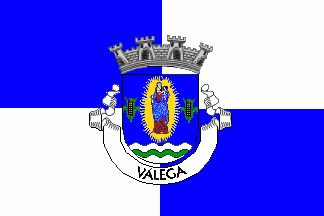
Flag of Válega, Portugal
- MANDORIA FLAMANT
- See mandoria.
- MAN O’ WAR
- A sailing, later steam-assisted, warship of the 17th, 18th or 19th centuries
(see also man-o-war pendant
and repeating frigates).
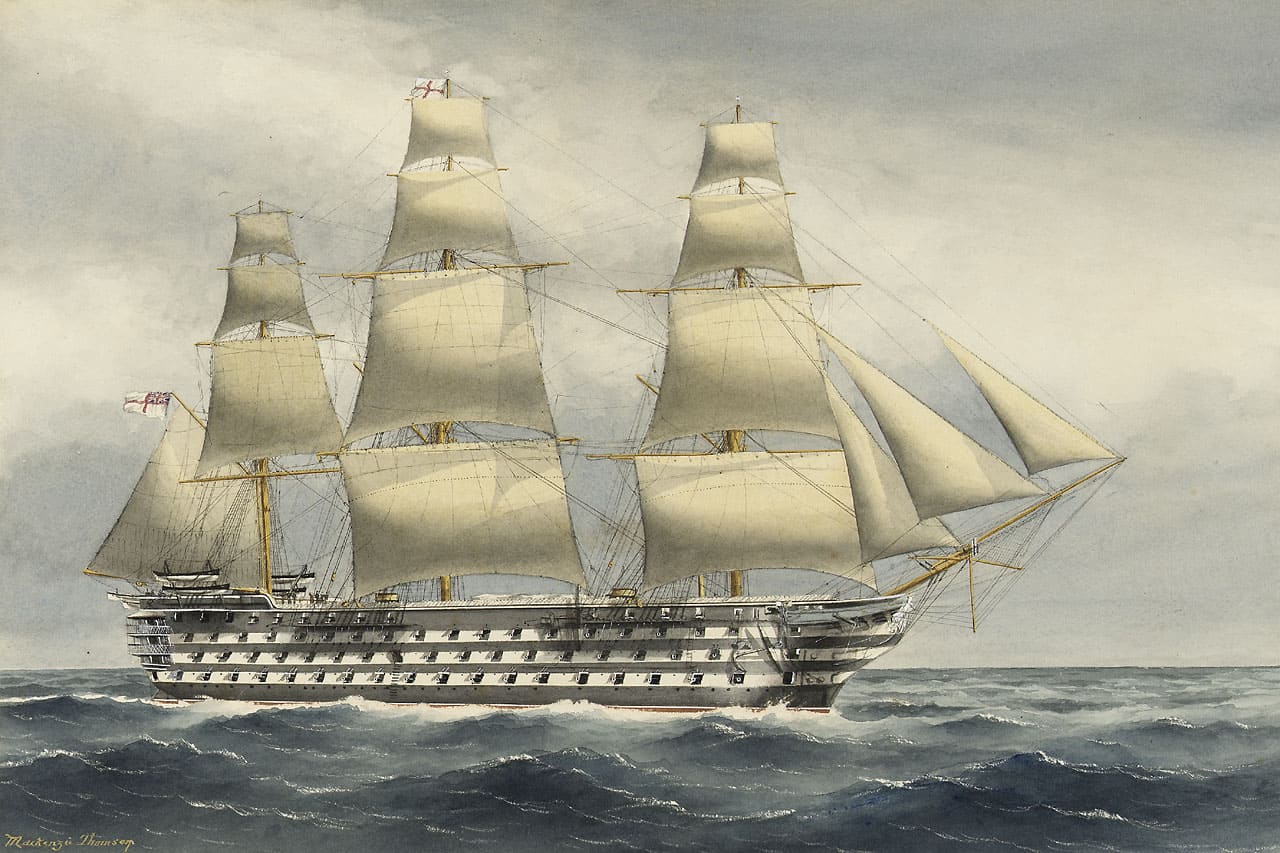
HMS Victoria of 121 guns 1858, UK (Wikipedia)
- MAN O’ WAR PENDANT (or PENNANT)
- In English, then British, usage, now obsolete, an alternative term for the commissioning or masthead
pennant – see
masthead pennant 1) (also common pendant
and man o' war).

Red Commissioning Pendant, England then UK c1625–1864 (CS)
Please note that in English then British usage only vessels of the Royal Navy are permitted to wear a pennant.
- MANTLE
- 1) A heraldic term for a cloak or robe behind the shield, and which can enclose
a full set of armorial bearings – but see the note a) below
(also armorial bearings).
2) See mantling 1) and mantling 2)
(also Appendix IV).
Notes
a) When used on the arms of a ruling
prince or sovereign a mantle becomes a pavilion.
b) Mantles may still be seen in
the parliamentary and state robes worn by British peers (which are graded according
to rank) – see "mantled 2)" (below).
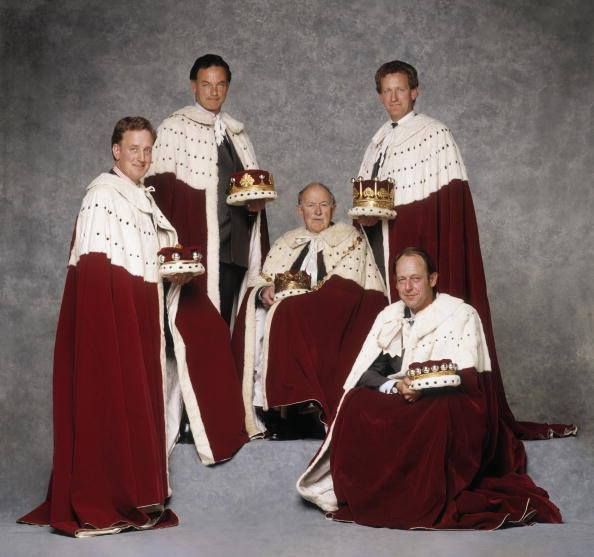
British Peers in Parliamentary Robes (pinterest.com)
- MANTLED
- 1) A term used in some European heraldic systems in place of per chevron or per pile reversed –
see per chevron and per pile
(also chapé).
2) A term sometimes also used in South European heraldic systems to describe the outer garment of a
usually religious person – but see the note below (also vested).
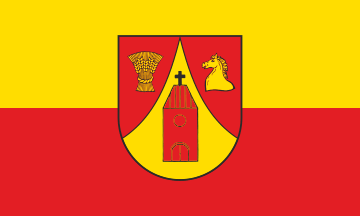
.gif)
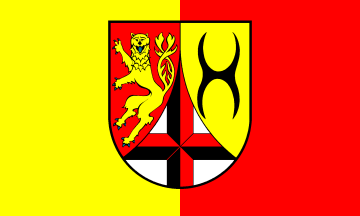
Flag of Körchow, Germany;
Arms and Flag of São Vicente, Portugal;
Flag of Altenkirchen County, Germany
Please note that the word "mantle" has been used in medieval and renaissance times to
describe an outer garment – see note b) at "mantle" (above) – however, its use in
English heraldry is much more restricted as may be seen from the entries for "mantle 1)" (above)
and "mantling" (below).
- MANTLING
- 1) A heraldic term for the decoration resembling drapery in a coat of arms, and
attached to the helmet by a torse – a mantle or cappeline (see also Appendix IV,
armorial bearings,
coat of arms and,
helm – for information on torse see
wreath 2)).
2) A heraldic term which some writers contend should also be used to describe the principal colour and
metal of the bearer’s arms.
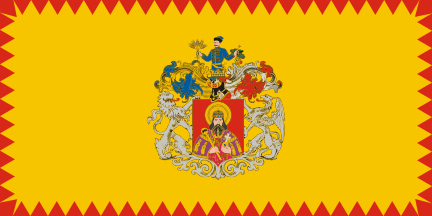
Flag of Miskolc, Hungary
Please note with regard to 1), that mantling (at least in this context) originated as a protective covering for the helmet.
- MAN-TRAP (or MAN TRAP)
- See
wolf-trap and its following note.
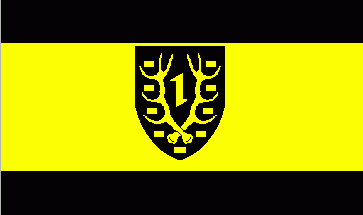
Flag of Kirchhundem, Germany
- MARCHING FLAG
- See
parade flag 1).
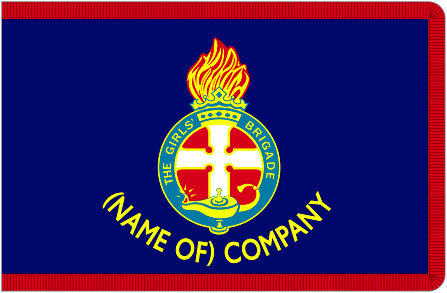
Girl’s Brigade Company Marching/Parade Flag, UK (Graham Bartram)
- MARIAN CROWN
- In Christian, particularly South European, tradition, a term (often misapplied) for a crown
(sometimes blue) bearing a star or stars on top, and said to symbolize the coronation of the Virgin Mary
– but see the note below and crown of the holy
spirit (also marian flag).
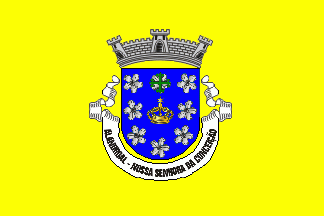
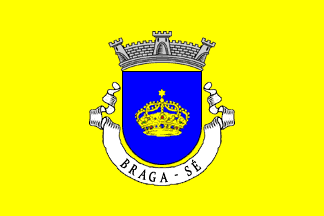
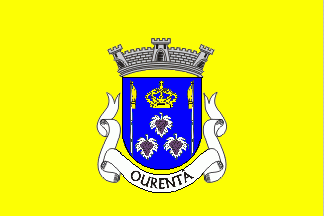
Flag of Alandroal (Nossa Senhora da Conceiço), Portugal;
Flag of Sé, Portugal;
Flag of Ourentã, Portugal
Please note that a Crown of the Holy Spirit (illustrated below) is often (sometimes officially)
misidentified as a Marian Crown.
.gif)
Arms of Manigoto, Portugal
- MARIAN FLAG
- One of a number of flags – most often a bicolour of blue and white – that
symbolizes veneration of the Virgin Mary in the Catholic tradition – see marian crown (also
Christian flag 1) and
religious flag).



Catholic Marian Flag (CS); Flag of the Catholic Church in Poland;
Flag of the Catholic Church in Malta
- MARITIME LIFESAVING FLAGS
- The flags of those organizations dedicated to saving life at sea (see also
storm warning flag).

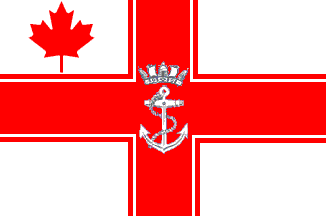
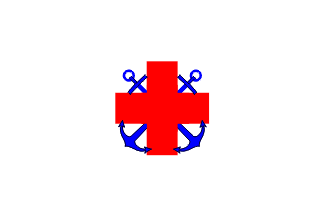
Lifeboat Society, Belgium (Željko Heimer);
Lifeboat Institution, Canada;
Water Rescue Society, Finland
- MARK
- 1. See union mark, merchant mark,
house mark and mon.
- 2. A term occasionally used (to describe the figure on a flag) in place of the more
precise (and to be preferred) descriptions contained herein – see
coat of arms 1),
emblem 1),
merchant mark,
seal,
shield and
symbol 1) (also
cadency, mark of).
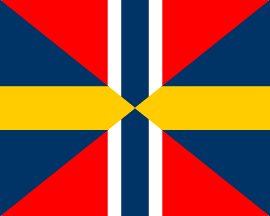
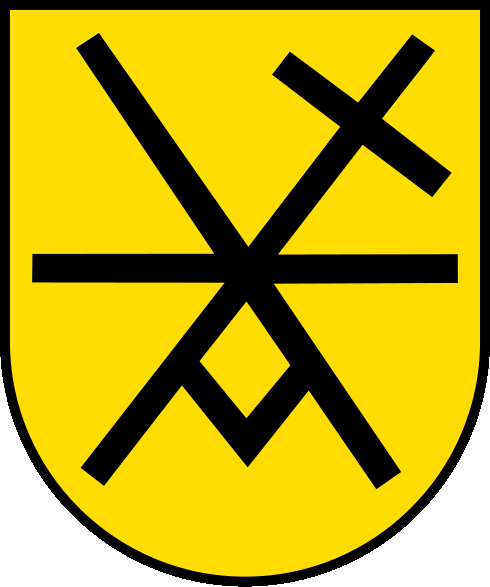

Norway-Sweden Union Mark and Naval Jack 1844–1905;
Arms of Bobenheim am Berg Germany (Wikimedia);
Presidential Flag of Bangladesh
- MARKING (or MARKER) PENNANT
- In US military usage and some others, a pennant used to mark the turning points
or limits of a parade ground (see also pennant 2)).
- MARKS OF CADENCY
- See cadency, mark of.
![[cadency marks]](../images/v/vxt-d062.gif)
The cadency marks of the 1st to the 6th son in English heraldry (Parker)
- MARKS OF DIFFERENCE
- 1) A phrase that may be used to describe those symbols which appear on the command/rank flags of
senior naval/military officers, and to distinguish between their various grades – see
balls of difference
(also flag of command and rank flag).
2) See device 2).
![[marks of difference]](../images/v/vx-pl-admir.gif)
![[marks of difference]](../images/v/vx-pl~vadm.gif)
![[marks of difference]](../images/v/vx-pl~radm.gif)
Flags of an Admiral, Vice-Admiral and Rear Admiral, Poland
- MARRYAT'S CODE (MARRYAT or MARRYAT’S CODE OF SIGNALS FOR THE MERCHANT SERVICE)
- The set of signal flags and pennants devised by Captain Frederick Marryat
RN for use by the merchant service
(see also distinction pennant 1),
International Code of Signal Flags,
pilot jack, signal flag
and telegraph flag 2)).
![[Marryat example]](../images/v/vx-myt~7.gif)
![[Marryat example]](../images/v/vx-myt~3.gif)
![[Marryat example]](../images/v/vx-myt~5.gif)
Flags 7, 3 and 5 in Marryat’s Code of
Signals for the Merchant Service
Please note that this code first was appeared in 1817 and went through several changes before being
supplanted by the Commercial Code of Signals (later the International Code of Signals) in 1857.
- MARSHALLING
- The heraldic term used to describe the process of arranging two or more different
coats of arms on the same shield or banner of arms – see
impale 1) and
quartering 1) (also banner of arms
and dimidiated).
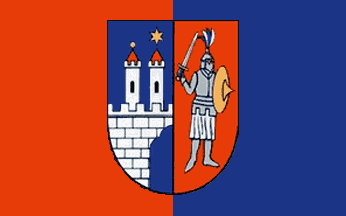
ka.gif)
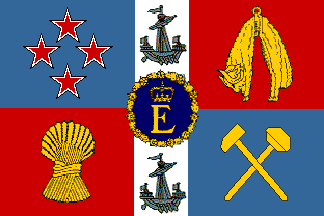
Flag and Arms of Kamienna Góra, Poland;
Royal Standard of New Zealand
- MARTLET
- The heraldic term for a small bird, always seen standing and usually (although not
invariably) shown with thighs but no visible legs – a merlette.
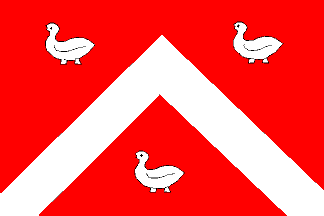
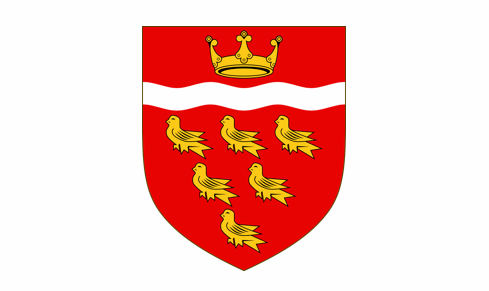
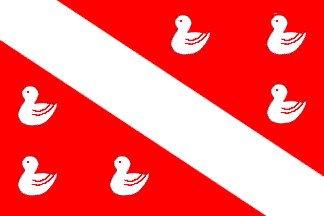
Flag of Ens, The Netherlands;
Flag of East Sussex, UK;
A Flag of Bergen, The Netherlands
- MASCLE
- The heraldic term for a voided lozenge – see
voided lozenge).
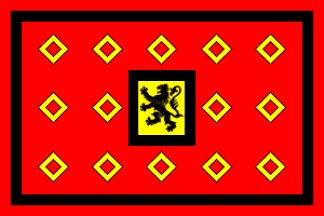
Flag of Landivisiau, France
- MASONED
- A heraldic term used to describe the lines formed by masonry blocks in a building.
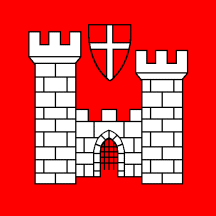
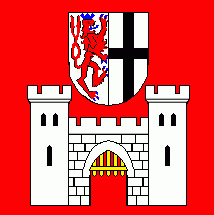
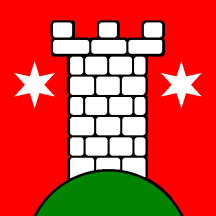
Flag of Romont, Switzerland;
Square Flag of Königswinter, Germany;
Flag of Aristau, Switzerland
- MAST
- 1) Any vertical projection from a vessel upon which sails and/or flags can
be hoisted (see also fore,
mizzen and
stumpmast).
- 2) See flag pole (also
pole mast,
sailor’s mast and
stayed mast).
- MASTHEAD
- The highest point below the truck of any mast afloat or ashore (see also
mast and truck).
- MASTHEAD, AT THE
- (adv) When a flag is flown at the truck of a mast or at a point below the
truck, it is said to fly 'at the masthead'.
- MASTHEAD FLAG
- 1) Generically, any flag hoisted at the masthead of a vessel (see also
mast and masthead).
- 2) Specifically, the national flags hoisted at the masthead of all masts when
a ship is dressed overall, usually the national flag of the nation being honoured
(see also dress ship).
- MASTHEAD PENNANT (or PENDANT)
- 1) A flag, usually long and narrow and often generally (but by no means exclusively) tapering
from hoist to fly, it can be triangular, cut off to a square, swallow-tailed
or a variation thereof,
and is flown from the main masthead of a naval or other public vessel in commission
but which does not carry a flag officer (or officer commanding other vessels)
on board – commissioning or commission pennant, narrow pennant, pennant of
command, war or warship pennant or of a warship commander and others (see also
broad command pennant,
broad pennant,
burgee command pennant,
command pennant, converging stripes,
flag officer,
flag of command,
flagship,
in commission,
naval ensign under ensign,
merchant pendant,
‘naval jack’ under jack,
pendant,
royal masthead pennant,
private ship and
suit of flags).
- 2) The generic name for any long narrow flag that is flown from the masthead
of a vessel – a whip pennant
(see also streamer 2),
homeward bound pennant or
paying off pennant).
![[Masthead Pennant - Spain]](../images/v/vxt-d207.gif)
Masthead Pennant of Spain
![[Masthead Pennant - Belgium]](../images/v/vxt-d209.gif)
Masthead Pennant of Belgium
![[Masthead Pennant - Taiwan]](../images/v/vxt-d5402.gif)
Masthead Pennant of Taiwan
Notes
a) A distinction has been drawn between
the standard masthead pennant flown by commissioned warships as defined in 1)
above, and the various command pennants that are flown in addition and subordinate
to it (see also command pennant).
b) There are three exceptions to this – the broad command pennant,
broad pennant
and the burgee command pennant –
all of which replace the masthead pennant when flown.
- MASTHEAD STREAMER
- See streamer 2).
![[Masthead streamer]](../images/v/vx-henrigrace.jpg)
The "Henri Grace à Dieu", English Royal Navy c1525 (Wikipedia)
- MATRICULAR FLAGS (PENNANTS or ENSIGNS)
- See ‘registration flags’ (also ‘insurance flag’).
![[matricular flag - Spain]](../images/v/vx-es~gc.gif)
![[matricular flag - Spain]](../images/v/vx-cu_remed.gif)
Matricular Ensign/Registration Flag of La Palmas de Gran Canaria, Spain c1870;
Matricular Ensign/Registration Flag of San Juan de los Remedios de Cuba, Spain c1850





.gif)







.gif)









![[cadency marks]](../images/v/vxt-d062.gif)
![[marks of difference]](../images/v/vx-pl-admir.gif)
![[marks of difference]](../images/v/vx-pl~vadm.gif)
![[marks of difference]](../images/v/vx-pl~radm.gif)
![[Marryat example]](../images/v/vx-myt~7.gif)
![[Marryat example]](../images/v/vx-myt~3.gif)
![[Marryat example]](../images/v/vx-myt~5.gif)

ka.gif)








![[Masthead streamer]](../images/v/vx-henrigrace.jpg)
![[matricular flag - Spain]](../images/v/vx-es~gc.gif)
![[matricular flag - Spain]](../images/v/vx-cu_remed.gif)

![[Masthead Pennant - Spain]](../images/v/vxt-d207.gif)
![[Masthead Pennant - Belgium]](../images/v/vxt-d209.gif)
![[Masthead Pennant - Taiwan]](../images/v/vxt-d5402.gif)